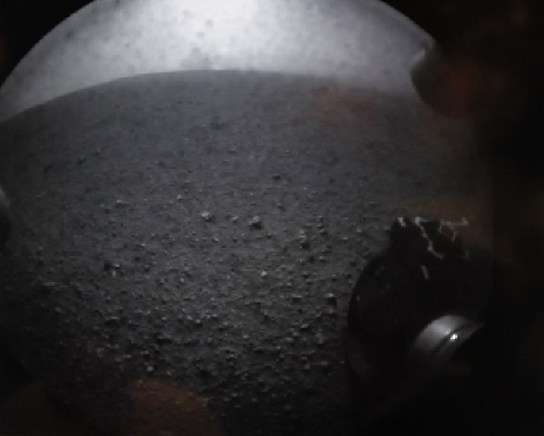Curiosity starts work on Mars
 0 Comment(s)
0 Comment(s) Print
Print E-mail Agencies via Shanghai Daily, August 7, 2012
E-mail Agencies via Shanghai Daily, August 7, 2012
|
 |
|
The photo, sent back by the robotic explorer Curiosity, shows the surface of Mars. |
In a show of technological wizardry, the robotic explorer Curiosity blazed through the pink skies of Mars, steering itself to a gentle landing inside a giant crater for the most ambitious dig yet into the red planet's past.
Cheers and applause echoed through the NASA Jet Propulsion Laboratory late on Sunday after the most high-tech interplanetary rover yet built signaled it had survived a harrowing plunge through the thin Mars atmosphere.
"Touchdown confirmed," said engineer Allen Chen. "We're safe on Mars."
Minutes after the landing signal reached Earth, Curiosity beamed back the first black-and-white pictures from inside the crater showing its wheel and its shadow, cast by the afternoon sun.
"We landed in a nice flat spot. Beautiful, really beautiful," said engineer Adam Steltzner, who led the team that devised the tricky landing routine.
It was NASA's seventh landing on Earth's neighbor; many other attempts by the US and other countries to zip past, circle or set down on Mars have gone awry.
The arrival was an engineering tour de force, debuting never-before-tried acrobatics packed into "seven minutes of terror" as Curiosity sliced through the Martian atmosphere at 21,000 kilometers per hour.
In a Hollywood-style finish, cables delicately lowered the rover to the ground at a snail-paced 3kph. A video camera was set to capture the most dramatic moments - the first glimpse of a touchdown on another world.
Celebrations by the mission team were so joyous over the next hour that JPL Director Charles Elachi had to plead for calm in order to hold a press conference. He compared the team to athletic teams that go to the Olympics. "This team came back with gold," he said.
The extraterrestrial feat was a much-needed boost for NASA, which is debating whether it can afford another Mars landing this decade. At a budget-busting US$2.5 billion, Curiosity is the priciest gamble yet, which scientists hope will pay off with a bonanza of discoveries.
US President Barack Obama called the landing "an unprecedented feat of technology that will stand as a point of national pride far into the future."
Over the next two years, Curiosity will drive over to a mountain rising from the crater floor, poke into rocks and scoop up rust-tinted soil to see if the region ever had the right environment for microscopic organisms to thrive. It's the latest chapter in the long-running quest to find out whether primitive life arose early in the planet's history.
The voyage to Mars took more than eight months and spanned 566 million kilometers. The nuclear-powered Curiosity, the size of a small car, is packed with scientific tools, cameras and a weather station.
It sports a robotic arm with a power drill, a laser that can zap distant rocks, a chemistry lab to sniff for the chemical building blocks of life and a detector to measure dangerous radiation on the surface.
Over the next several days, Curiosity is expected to send back the first color pictures. After several weeks of checkups, the six-wheel rover will take its first short drive. Its goal is to scour for basic ingredients essential for life, including carbon, nitrogen, phosphorous, sulfur and oxygen.






Go to Forum >>0 Comment(s)